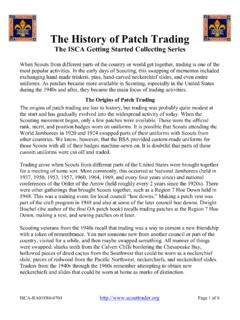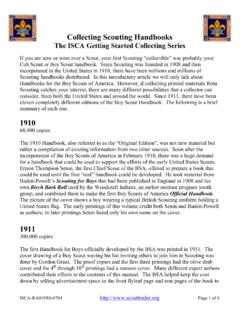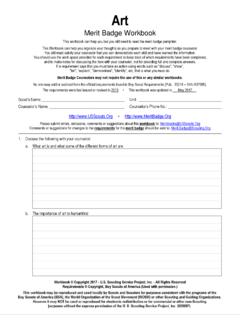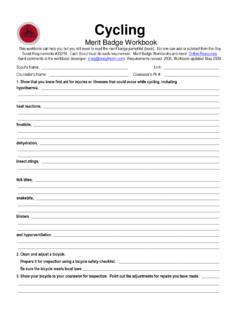Transcription of Collecting Merit Badges - ISCA
1 ISCA-RA025R0-0105 Page 1 of 13 Collecting Merit Badges The ISCA Getting Started Collecting Series If you have been a Boy Scout long enough to have gone to summer camp, then you have probably earned a Merit badge . Congratulations! You are in good company. Merit Badges have been an important part of Scouting since its start. Since 1910, well over one hundred million boys have earned well over one hundred million Merit Badges . Earning Merit Badges is fun, and it also helps you learn important skills on the trail to Eagle. The Badges that you earn should be sewn on your sash and then proudly worn at Courts of Honor and other special events, just like your millions of predecessors have done. Imagine for a moment that you were a Scout during the early days of Scouting in the US after 1910.
2 Like today, you could earn Merit Badges for Archery, Art, Architecture, Aviation, Astronomy, Athletics, Bugling, Camping, Chemistry, Cooking, Cycling, Electricity, First Aid, Forestry, Gardening, Horsemanship, Lifesaving, Music, Painting, Photography, Pioneering, Plumbing, Public Health, Scholarship, Sculpture, Surveying, and Swimming. There were many more Merit Badges that you could have earned then that are similar to those of today. For example the Angling Merit badge became the Fishing Merit badge in 1951. Civics became Citizenship in 1946, and in 1952, Citizenship expanded into Citizenship in the Community, Citizenship in the Home, and Citizenship in the Nation. The interpreting badge was discontinued in 1952, but some of its requirements became part of World Brotherhood in 1969, which became Citizenship in the World in 1972.
3 There are quite a few Badges from Scouting s early days that no longer exist though. For example, Blacksmithing (1911-1952), Craftsmanship (1911-1925, which could be earned up to eight times with different requirements for different crafts), Machinery (1911-1995), Pathfinding (1911-1952), Signaling (1911-1992), and Taxidermy (1911-1953) Merit Badges no longer exist. Many other Badges have been discontinued, renamed, or changed, while new Badges were started. One of the newer Merit Badges is Cinematography (1989-present), and Steven Spielberg, the famous director and a former Scout, helped write the requirements for it. For every badge like Foundry Practice (1923-1952), Masonry (1911-1995), and Stalking (1915-1952) that disappeared, there is a new one like Type A, Blacksmithing ISCA-RA025R0-0105 Page 2 of 13 Atomic Energy (1964-current), Space Exploration (1965-current), and Computers (1967-current) to take its place.
4 Merit Badges have changed in many ways over the years, and yet in many ways they have stayed the same. The original 1910 BSA handbook listed 14 Merit Badges , eight of which were pictured with drawings. The original 14 Merit Badges were Ambulance, Clerk, Cycling, Electrician, Fireman, Gardner, Horseman, Marksmanship, Master-of-Arms, Musician, Pioneering, Seamanship, Signaling, and Stalker. None of these are known to actually exist, and they probably were never made. The 1911 handbook named the first 57 Merit Badges that were actually awarded. Early Scouts sewed their Badges on sashes, like today, but the first sashes were homemade, and that is not the only way that Merit Badges were worn. Some Scouts wore their Merit Badges on their right sleeve. Other Scouts wore their Badges on a removable sleeve, or false sleeve, that they wore over their regular sleeve on special occasions.
5 In the early days, many Scouts sewed rank patches and other patches on their sash as well, sometimes even on the back. Some sashes were two Badges wide and some (like today) were three Badges wide. Today, any Boy Scout under the age of 18 may earn Merit Badges . It was not always that way. During various times in Scouting s history, you had to be at least Second Class to work on Merit Badges , and at other times, you had to be at least First Class. At first, any Scout or Scouter could work on Merit Badges and advance to Eagle. Adults in some councils could earn Merit Badges and become Eagle Scouts up until 1965. Type A, Craftsmanship Type A, Pathfinding ISCA-RA025R0-0105 Page 3 of 13 False Sleeve with Square Merit Badges ISCA-RA025R0-0105 Page 4 of 13 Merit Badges have always been a major part of Scouting.
6 That makes them very collectible. Merit Badges that you collect are quite different from Merit Badges that you earn though. You do not wear Merit Badges that you collect. Merit Badges are fun to collect because there are lots of Badges that you can get for very little money. There are also many older and rarer ones that are expensive, but you will not need to worry about them when you are starting out. All Merit Badges since 1911 have had an embroidered circular border with an emblem inside, just like the Badges of today. However, there are many ways in which the Merit Badges from the early days of Scouting are different from those of today. Merit Badges over the years have come in ten different types and are designated by the letters A through J. Type A Merit Badges are called square Merit Badges .
7 They were issued from approximately 1911-1933. They consist of a piece of square or rectangular cloth with an embroidered design. The sides of the cloth were folded under to form a smaller square before they were sewn on the sash. Some square Merit Badges are called teens or type AA Badges . The Merit Badges issued during the first decade of the BSA, the twentieth-century teen years, were often different from the square Merit Badges that followed in the 1920s and early 1930s. Teens Merit Badges are highly prized, and new variations are still being discovered even to this day. Even some of the oldest square and teen-era square Merit Badges are fairly common today and can easily be obtained for your collection, particularly those that were required for Eagle, since so many of them were earned.
8 However, many square Merit Badges and most of the teens Badges are very rare. There are two square Merit Badges , Invention and Stalking (leaf), that are thought to exist, but none has ever been seen! Type A, Square Aviation, Beekeeping, and MachineryISCA-RA025R0-0105 Page 5 of 13 Type A, Square on the left and a Teens Variety on the right. Lifesaving, First Aid to Animals, and Mining ISCA-RA025R0-0105 Page 6 of 13 Type B Merit Badges are called wide border crimped Merit Badges . They were issued from approximately 1934-1935. The outside cloth was folded under by the manufacturer and crimped or pressed into place forming a wide circle of cloth around the border.
9 Several later types of Merit Badges were crimped as well. The thing that distinguishes the wide bordered crimped Badges is the amount of cloth between the embroidered border and the edge of the badge . The width of the outside cloth is approximately 3/16 to 1/4 inch in diameter. Wide border crimped Merit Badges were not used for long, and so they are one of the harder types to find, but many are quite affordable. Type C Merit Badges are called tan narrow border crimped Merit Badges . They were issued from approximately 1936-1946. The tan-colored cloth was folded under by the manufacturer and crimped into place leaving a narrow, approximately 1/8-inch border. Examples of this type of badge can easily be obtained for your collection, particularly those that were required for Eagle. These Badges are very similar to type E Badges , which are khaki colored.
10 Some of the tan Badges have a slight olive or khaki tint to them, but the khaki Badges are a darker green. When in doubt, look at your badge in the sunlight. If there is only the slightest tint of green, it is probably a tan badge . Type C, Tan Narrow Border Crimped Carpentry, Camping, Woodwork, and Leatherwork Type B, Wide Border Crimped Archery and Stalking ISCA-RA025R0-0105 Page 7 of 13 Type D Merit Badges are called fine twill Merit Badges . They were issued from approximately 1942-1946. They were crimped and are very similar to type C tan narrow border crimped Merit Badges . The difference is they were made from a lighter-weight cloth with very fine twill, sometimes called a sand twill. The change was due to Scouting s attempts to help the war effort in WW II.







